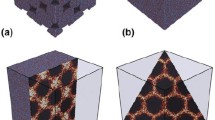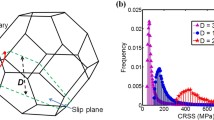Abstract
Experimental and simulation studies have shown that decreasing the grain size below a critical value results in softening rather than hardening in both the yield stress and flow stress of nanomaterials. In this work, a gradient plasticity framework is presented that can capture this softening behavior by treating grain boundaries as a separate phase with a finite thickness. The theoretical expression obtained for the yield stress as a function of the grain size can capture numerous experimental data that exhibit this “normal” to “abnormal” Hall–Petch transition, and an analytical equation is obtained that can predict the grain size at which this transition occurs. Furthermore, analytical expressions are obtained for the flow stress in nanomaterials, and they are in precise agreement with atomistic simulations on nanocrystalline Cu, which predict that below a critical grain size the flow stress decreases proportional to it.






Similar content being viewed by others
REFERENCES
P.G. Sanders, J.A. Eastman, and J.R. Weertman: Elastic and tensile behavior of nanocrystalline copper and palladium. Acta Mater. 45, 4019 (1997).
X.D. Liu, Z.Q. Hu, and B.Z. Ding: Hall-Petch relation in nanocrystalline Fe-Mo-Si-B alloys. Nanostruct. Mater. 2, 545 (1993).
T. Volpp, E. Göring, W.M. Kuschke, and E. Arzt: Grain size determination and limits to Hall-Petch behavior in nanocrystalline NiAl powders. Nanostruct. Mater. 8, 855 (1997).
J. Narayan, R.K. Venkatesan, and A. Kvit: Structure and properties of nanocrystalline zinc films. J. Nanopart. Res. 4, 265 (2002).
R. Venkatesan, A. Kvit, Q. Wei, and J. Narayan: Novel tungsten carbide nanocrystalline composites by pulsed laser deposition, in Structure and Mechanical Properties of Nanophase Materials—Theory and Computer Simulations vs. Experiment, edited by D. Farkas, H. Kung, M. Mayo, H. Van Swygenhoven, and J. Weertman Mater. Res. Soc. Symp. Proc. 634, Warrendale, PA, 2000), B6.1.1.
A.H. Chokshi, A. Rosen, J. Karch, and H. Gleiter: On the validity of the Hall-Petch relationship in nanocrystalline materials. Scr. Metall. 23, 1679 (1989).
G. Palumbo, U. Erb, and K.T. Aust: Triple line disclination effects on the mechanical behaviour of materials. Scr. Metall. Mater. 24, 2347 (1990).
M. Zhao, J.C. Li, and Q. Jiang: Hall–Petch relationship in nanometer-size range. J. Alloy. Comp. 361, 160 (2003).
L. Lu, X. Chen, X. Huang, and K. Lu: Revealing the maximum strength in nanotwinned copper. Science 323, 607 (2009).
M. Meyers, A. Mishra, and D. Benson: Mechanical properties of nanocrystalline materials. Prog. Mater. Sci. 51, 427 (2006).
C.S. Pande and K.P. Cooper: Nanomechanics of Hall–Petch relationship in nanocrystalline materials. Prog. Mater. Sci. 54, 689 (2009).
G. Saada and G. Dirras: Chapter 90 Mechanical properties of nanograined metallic polycrystals, in Dislocations in Solids Volume 15, edited by J.P. Hirth and L. Kubin (Elsevier, Amsterdam, 2009), p. 199.
J.E. Carsley, J. Ning, W.W. Milligan, S.A. Hackney, and E.C. Aifantis: A simple, mixtures-based model for the grain size dependence of strength in nanophase metals. Nanostruct. Mater. 5, 441 (1995).
D.A. Konstantinidis and E.C. Aifantis: On the “anomalous” hardness of nanocrystalline materials. Nanostruct. Mater. 10, 1111 (1998).
K.E. Aifantis and A.A. Konstantinidis: Hall–Petch revisited at the nanoscale. Mater. Sci. Eng., B 163, 139 (2009).
K.E. Aifantis and A.A. Konstantinidis: Yielding and tensile behavior of nanocrystalline copper. Mater. Sci. Eng., A 503, 198 (2009).
K.E. Aifantis and J.R. Willis: The role of interfaces in enhancing the yield strength of composites and polycrystals. J. Mech. Phys. Solids 53, 1047 (2005).
J. Schiotz, T. Vegge, F.D. Di Tolla, and K.W. Jacobsen: Atomic-scale simulations of the mechanical deformation of nanocrystalline metals. Phys. Rev. B 60, 11971 (1999).
J.C.M. Li: Grain boundary impurity and porosity effects on the yield strength of nanocrystalline materials. Appl. Phys. Lett. 90, 041912 (2007).
R.W. Armstrong, H. Conrad, and F.R.N. Nabarro: Meso-to-nano-scopic polycrystal/composite strengthening, in Mechanical Properties of Nanostructured Materials and Nanocomposites, edited by I. Ovid'ko, C.S. Pande, R. Krishnamoorti, E. Lavernia, and G. Skandan (Mater. Res. Soc. Symp. Proc. 791, Warrendale, PA, 2004), p. 69.
M. Ke, S.A. Hackney, W.W. Milligan, and E.C. Aifantis: Observation and measurement of grain rotation and plastic strain in nanostructured metal thin films. Nanostruct. Mater. 5, 689 (1995).
I.A. Ovid'ko and A.G. Sheinerman: Enhanced ductility of nanomaterials through optimization of grain boundary sliding and diffusion processes. Acta Mater. 57, 2217 (2009).
H.S. Kim, Y. Estrin, and M.B. Bush: Constitutive modelling of strength and plasticity of nanocrystalline metallic materials. Mater. Sci. Eng., A 316, 195 (2001).
H.S. Kim, Y. Estrin, and M.B. Bush: Plastic deformation behaviour of fine-grained materials. Acta Mater. 48, 493 (2000).
R.W. Armstrong: Plasticity: Grain size effects II, in Encyclopedia of Materials: Science and Technology, edited by K.H.J. Buschow, W.C. Robert, C.F. Merton, I. Bernard, J.K. Edward, M. Subhash, and V. Patrick (Elsevier, Oxford, England, 2005), p. 1.
H.H. Fu, D.J. Benson, and M.A. Meyers: Analytical and computational description of effect of grain size on yield stress of metals. Acta Mater. 49, 2567 (2001).
M.A. Meyers and E. Ashworth: A model for the effect of grain size on the yield stress of metals. Philos. Mag. A 46, 737 (1982).
M.Y. Gutkin, I.A. Ovid’ko, and N.V. Skiba: Strengthening and softening mechanisms in nanocrystalline materials under superplastic deformation. Acta Mater. 52, 1711 (2004).
I.A. Ovid’ko: Superplasticity and ductility of superstrong nanomaterials. Rev. Adv. Mater. Sci. 10, 89 (2005).
K.A. Padmanabhan and H. Gleiter: Optimal structural superplasticity in metals and ceramics of microcrystalline- and nanocrystalline-grain sizes. Mater. Sci. Eng., A 381, 28 (2004).
K. Aifantis and A. Ngan: Modeling dislocation—grain boundary interactions through gradient plasticity and nanoindentation. Mater. Sci. Eng., A 459, 251 (2007).
D. Tabor: The Hardness of Metals (Oxford University Press, 2000).
A.S. Argon and S. Yip: The strongest size. Philos. Mag. Lett. 86, 713 (2006).
X. Zhang and K.E. Aifantis: Accounting for grain boundary thickness in the sub-micron and nano scales. Rev. Adv. Mater. Sci. 26, 74 (2010).
E.C. Aifantis: On the microstructural origin of certain inelastic models. Trans. ASME, J. Eng. Mat. Techn. 106, 326 (1984).
ACKNOWLEDGMENT
The authors are grateful to KEA’s European Research Council Starting Grant MINATRAN 211166 for its support.
Author information
Authors and Affiliations
Corresponding author
Rights and permissions
About this article
Cite this article
Zhang, X., Aifantis, K.E. Interpreting the softening of nanomaterials through gradient plasticity. Journal of Materials Research 26, 1399–1405 (2011). https://doi.org/10.1557/jmr.2011.123
Received:
Accepted:
Published:
Issue Date:
DOI: https://doi.org/10.1557/jmr.2011.123




